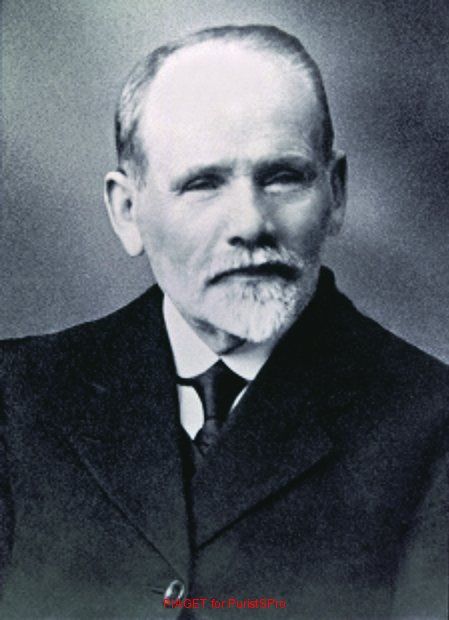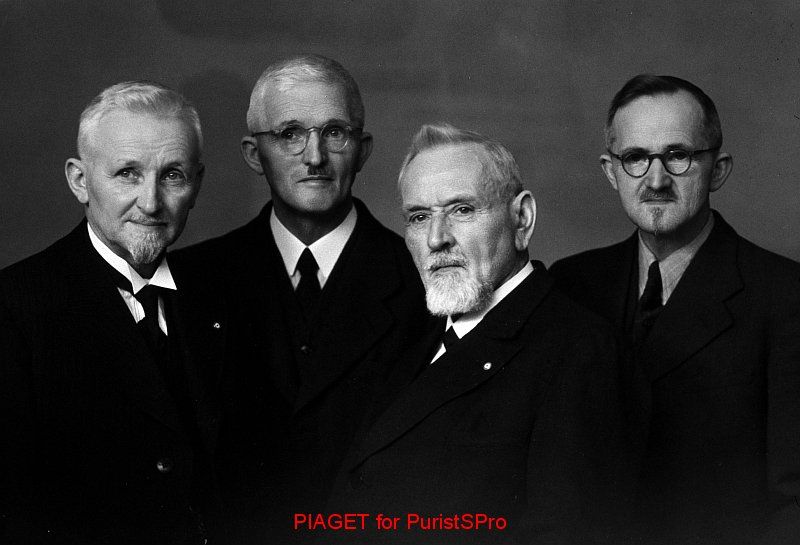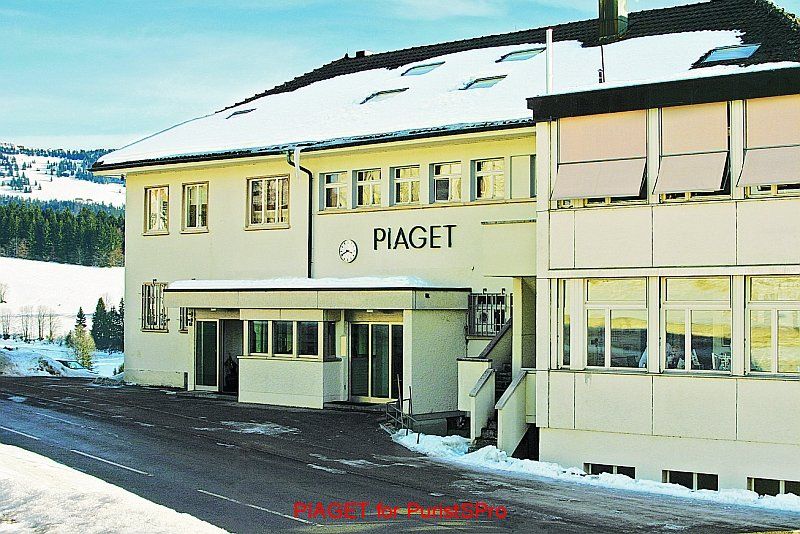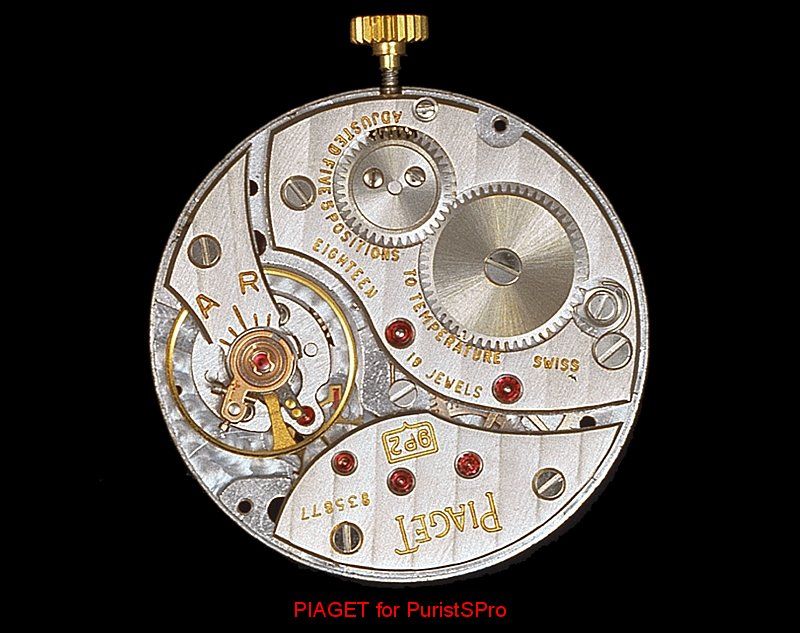
MTF
[PuristS]
13383

PIAGET – A Family History of “Luxury and Precision”: 1874 – 1988
PIAGET – A Family History of “Luxury and Precision”: 1874 – 1988
[Editor's Note: "Luxury and Precision" was a previous advertising motto used by Piaget]
Many watch aficionados are not even aware that Piaget has been one of the most important Swiss makers of ébauches or movement components for more than 130 years. Known as the Watchmakers' Watchmaker, their ‘silent’ clients included Audemars Piguet, Breguet, Cartier, Ebel, Longines, Omega, Rolex, Ulysse Nardin, Vacheron & Constantin, Vulcain, Wittnauer and Zenith. Even more silent clients still demand anonymity…..shhhh.
Of Fairies and Sheep
La Côte-aux-Fées means ‘Fairy Slope’ in regular French. That sounds dainty but not really, because ‘fées’ is a corruption of ‘fayes’, which, in the old Neuchâtel dialect, means nothing more phantasmagorical than ‘sheep’. This is evident on the village crest that depicts one of the their famous inhabitants.

La Côte-aux-Fées Crest
There is even a local cave called ‘La Grotte aux Fées’ that means ‘Fairy Cave’. The ‘Cave with the Fairies’ is allegedly where the last fairy of the area lived. The Last Fairy was reputed to be irksome. Les Niquelets (inhabitants of La Côte-aux-Fées) became weary of its jokes. During building construction in the village, the fairy was annoyed not to be asked to protect the workmen. Each night, it left the cave to disturb their sleep and to destroy their work. The locals thought out their revenge. They knew of fairy vanity and love of luxury footwear; making a charming shoe coated inside with pitch and that they firmly nailed into the ground. That night, the fairy falls into the trap and does not manage to withdraw its foot. The workmen sue for peace in exchange for its liberty; it should not destroy their work again. The fairy kept its word, so much so, that nobody ever sees it again.

La Grotte aux Fées
Even if the fairies have deserted the cave, it remains an interesting destination. It is accessible from Saint-Olivier, passing pastures, and then the forest. Take a flashlight, good shoes and of old, warm clothes as the entrance is narrow and dirty.
Of Geography and Religion
When you first visit the pretty little Swiss Jura village of La Côte-aux-Fées perched on a high plateau (1,040 meters) only 2 km from the French border, you may not understand why the current owners, Richemont Group, did not consolidate everything in Geneva with the rest of the Piaget manufacturing facilities. It takes a little investigation to discover the historic and cultural reasons for keeping the movement production in the Jura.
Piaget is a common family name in La Côte-aux-Fées and the canton of Neuchâtel, with many people either engaged in or with a family history of watchmaking. This implies that there were several watchmakers of the same name before the company was founded. This is supported by the existence of watches signed ‘Piaget’ in the manufacture’s museum that were made between 1820 and 1836, before the company was founded.
The 16th century Reformation shaped the environment in the canton of Neuchâtel and the people who settled there. The region was conquered by Guillaume Farel (1489 – 1565), French-born but naturalised Swiss, fanatical Lutheran disciple of Huldrych Zwingli and later the persuader of Calvin to visit Geneva. Strict and austere morals took hold in the region and idleness became the least tolerated of the ‘seven deadly sins’.
The Piagets’ ancestors were Upper Savoy Huguenots who settled in Switzerland as refugees after King Louis XIV of France revoked the Edict of Nantes (1600) with the Edict of Fontainebleau (1685); the former had granted freedom of religion. These isolationist Protestant farmers lived for centuries in the Jura with few outside contacts. They were industrious, resourceful people who strived for perfectionism in whatever they did, including crafting their own metal tools and implements. The mastery of these skills was invaluable when watchmaking started in the Swiss Jura from the early 17th century. Eventually, watchmaking took over from the traditional craft of lace-making in the mid-19th century.
Of Family and Endeavour

Georges Édouard Piaget - Founder
In 1874, at the age of nineteen years, Georges Édouard Piaget (1855-1931), founded a movement workshop and devoted himself to perfecting the lever escapement to new levels of thinness. A native of Renan (near St. Imier) in the Jura region of canton Bern, he removed to La Côte-aux-Fées, where he bought himself a farmhouse. Like many of his contemporaries, Georges was a paysan horloger who farmed his fields during the short summers, and then hand-crafted high-quality lever escapements as a cottage industry during the long winter months, when their village was isolated from the world by the heavy snows that closed mountain passes.

Winter isolation
The best workplaces for watchmakers were at the north-facing windows providing diffused light. People worked through the long winter evenings using ‘quinquets’ (oil lamps with green lampshades) to illuminate their work.

1942: 2 metres of snowfall in La Côte-aux-Fées

Mr and Mrs Georges Piaget and 14 children
Georges Piaget ‘begat’ seven sons and seven daughters but watchmaking was much more than a winter job to feed his large family. He was driven by a passion for what we now call 'haute horlogerie'. His credo was “Faire toujours mieux que nécessaire” (Always do better than necessary). Never satisfied with outcomes that were merely “good,” he insisted that the work exceeded expectations. He invented new mechanisms that improved the accuracy of his watch movements. He only made propositions with top-quality lever escapements and within a few decades, Piaget was compelled by success to build new workshops. In 1890, the workshops were moved from the farmhouse to the ground floor of the Free Evangelical Church of La Côte-aux-Fées.
Within two generations, watchmaking had become the family’s full-time speciality. The Piagets abandoned farming, and some family members even took up commercial trades to survive in the economy of those times. In 1911, the founder’s third son, Timothée Piaget (1885 – 1975), takes over management of the business that has become a partnership company and Piaget begins to supply the top Swiss brands. Through the 1920s and 1930s, Piaget manufactures ultra-thin, high quality movements. In 1943, Gérald (1917 – 1997), Valentin (1922 – ), grandsons of the founder, and their father Timothée, registered the Piaget trademark and incorporated a new firm with one very long name – ‘SA Ancienne Fabrique Georges Piaget & Cie., La Côte-aux-Fées’ . The old workshop began making watches signed and sold as Piaget watches.

Founding Fathers
In 1945, again Piaget was compelled by success to build a new Manufacture in La Côte-aux-Fées; the building is still in use today although much expanded. Villagers regarded the new ‘La Fabrique’ as an almost religious temple of good works where, in addition to complete watches, they also crafted watch movements of the finest quality, which were sold to other watchmakers in Geneva and Paris. The bulk of movement production was for a few prestigious brands and a very small number of Piaget trademarked watches.

Piaget Manufacture built in 1945 (photo taken in 1947)
Of Church and La Fabrique

The locals stuck to their deeply Calvinist ideals of humility and understatement, although the name “Piaget” had begun to appear on the dials of the company's watches. The founder probably would have objected to the family name being displayed so prominently; the Calvinist ethic maintained that when something is of acknowledged quality, there is no need for a vulgar signature.
When the designers of a Piaget Jubilee watch wanted to engrave a facsimile of Georges Piaget’s signature, they could not find any copies in the company archives. There was much relief when they found one in the local church register.

1946: Religious Temple at La Côte-aux-Fées
People spoke of the manufacture in hushed tones as if it were a temple, which one entered with reverence and stayed in ‘congregation’ with body and soul. For the Les Niquelets, the most natural thing in the world was to consider work as a godly activity. Remember that the first Piaget ‘factory’, after moving out of the farmhouse, had occupied the ground floor of the Free Evangelical Church in 1890. The pastor lived on the floor above. Less well known or remembered is that the second Piaget factory was a building that had been a ‘public house’ that served alcoholic beverages.
When shorter 5-day weeks were introduced and nobody was expected to work on Saturdays, the employees were unsettled. Despite assurances that their wages would remain unchanged, they felt that working fewer hours for the same remuneration was redolent of being idle and lazy; both were major sins from a Calvinist point of view. The Bible was read aloud during working hours to fortify the soul and nourish the spiritual well-being of Piaget watchmakers. Piaget employees were transported each day, back to their homes to have lunch with their families. The company used their own small fleet of company mini-buses for this purpose to encourage the virtues of family life. After lunch, they were transported back to work.

Blue uniform of the mechanics
Office worker and watchmaker alike wore immaculately clean white laboratory coats. Even the Director and executives conformed to the dress code. In strict Swiss compartmentalisation, the one exception was the blue coverall uniform worn in the mechanics’ workshop.
When there were no Bible readings nor running machinery, there was a pious silence in the workshops. When some young employees asked for a workshop radio in the 1950s, senior co-workers objected to the ‘immoral influence’. An amicable solution was a wire-feed to each work area and optional headphones.
Of the Rich and the Famous
In 1945, Gérald Piaget became Chairman and Managing Director of the business and he travelled widely as the public face of Piaget. His family saw little of him because of frequent international business trips. Valentin Piaget became Deputy Director and in charge of technical development and production at the Manufacture. Camille Pilet was the International Sales Director and he later achieves bizarre notoriety after retirement, with his demise and involvement with a mysterious cult mass murder-suicide spanning Switzerland and Canada in 1994.
The introduction of cal.9P hand-wind (2.00mm) ultra-thin movement in 1956 and the unveiling of cal.12P automatic (2.3mm) World’s thinnest self-winding movement in 1960, both established Piaget’s fame as the ultra-thin watch specialist. The cal. 9P was particularly noteworthy because of its robustness despite being so thin; Valentin’s cunning construction was also very simple to repair.


By the mid-1950s, micro-engineers had pushed horological limits that seemed impossible to improve upon. Better materials science, high-beat balances, and production automation made marginal improvements. The Age of Electronics was upon us and quantum leaps would be possible only by electromechanical or electronic means. Clocks with motorised balances and watches with tuning forks led to quartz watches. The Piagets did not embrace the motorised balance, but they were enamoured by the Swiss version of the tuning-fork concept, the so-called ‘Mosaba’ (Ebauches SA). Gérald and Valentin Piaget purchased Baume & Mercier in 1963; using that brand to launch the ‘Tronosonic’, a watch with the Mosaba movement.
In 1965, Yves Piaget (Gérald’s son) received a diploma as a watch engineer from the University of Neuchâtel. Between terms at university, he spent his 'vacation time' in the Piaget boutique and office in Geneva, learning practical skills in sales and marketing. He gained a diploma in gemmology and gemstone mineralogy in Los Angeles. The firm decided to invest more into the jewellery-watch division and developing vertical integration. Piaget bought companies that had formerly been outsourcing suppliers so they could manufacture their own watch cases, watchbands, and especially dials, in Geneva. Furthermore, the company decided it would use only gold or platinum for its watch cases. The two official exceptions since then have been the steel Upstream in 2001 and titanium Polo FortyFive in 2009
In 1969, Piaget takes part in the manufacture of the first Swiss quartz movement (1300 Bêta 21 calibre) with the Centre Electronique Horloger (CEH), a joint laboratory of the Swiss watchmaking industry in Neuchâtel, founded in 1961. A Piaget subsidiary – ‘Complications SA’ – was a shareholder of CEH and Yves Piaget joined the scientific advisory panel in 1966. Many of the eight watch companies involved saw their investment in micro-electronics as a back-burner plan because nobody believed there was a future in ‘electronic movements’ for Swiss haute horlogerie.
Piaget continued to invest in quartz technology after launching two gold watches equipped with the large Caliber Beta 21. Today, that movement’s dimensions (29 x 24.3 x 5.3 mm) are considered ‘massive’ in comparison to modern electronics. Piaget needed something smaller for their future plans. Piaget established an in-house electronics division, which soon began mass producing quartz movements to ensure independence from Ebauches SA and later from ETA. This proved a wise move when the "Quartz Crisis" hit a few years later.

Quartz movements were also manufactured in-house
Of Crises and Resurrection
Piaget is one of the three firms (with Rolex and Swatch Group) that are still members of CSEM, the laboratory that succeeded CEH. The ‘Great Quartz Crisis’ was associated with several interconnected factors: a Middle-East war (Arab-Israeli) in 1973; the subsequent politics of OPEC reduction oil production; and the weakness of the US dollar (Editor’s Note: All too familiar recurrent themes even in 2008). Shortly afterwards, the two big Japanese watch companies – Seiko and Citizen – dominated the market for mass-produced quartz watches of excellent quality at low prices.
Although big Swiss producers of cheap watches collapsed with the loss of 60,000 jobs, nobody was fired at Piaget. It was neither the Calvin nor the family way, no matter how bad the economy was. Piaget had selected the best workers and so they could expect lifelong tenure until retirement. Astonishingly, they continued to take in the same number of apprentices during the crisis because business actually grew. Using Calvinistic ethos, Piaget ran without bank loans and financed itself with any means possible 'in-house', although local banks may have "helped out" when the company needed additional cash. Maybe they shared the same values. The family did not sell any shares nor pay out dividends; all the profits were reinvested. As for technical development, Piaget was at the forefront globally. It was the only producer that could make exquisite jewellery watches with its own quartz movements.

Yves Piaget, Former President and now Chairman of Piaget
In 1974, Yves Piaget (1942 – ) sat beside his father Gérald and his uncle Valentin as a general director of the company. Yves took on more responsibility in 1980, when Gérald decided to reduce his own workload after an automobile accident. Gérald Piaget retired in 1982 at 65 years of age and Yves becomes President and Managing Director.
In 1976, Piaget produced the Caliber 7P, the smallest quartz movement at the time. Valentin and Yves worked with CEH to develop a small, flat, quartz movement to be produced in small series for Piaget. The 3.1-mm thin Caliber 7P was ideal for tiny jewellery watches.

The Jet-Set and Polo
In 1979, Piaget’s ascendancy increased further when the sporty Polo, with the iconic striped pattern of glossy and matte gold, became the de riguer accessory amongst jet-setters. This was the first gold wristwatch with an integrated bracelet. It was described as “a jewellery bracelet with a built-in crownless watch”. The watch was originally equipped with the Caliber 7P. A key selling feature was that the hour hand could be readjusted without affecting the position of the minute hand: useful to the jet-set who frequently change time zones.


1st Piaget Polo watches had Cal. 7P movements
In 1981, the 2.0 mm thin Caliber 8P, with a standard 32 kHz quartz crystal was introduced. Piaget was a true pioneer in electronic watches. By the end of the 1970s, quartz movements accounted for 65% of total production, but Piaget never entirely abandoned mechanical watchmaking.
With a resurgence of popularity since 2000, mechanical watches again accounted for the majority of Piaget total production (51%) by 2007. Now, mechanical watch production out-numbers quartz powered jewellery watches.......the Watchmaker's Watchmaker is back: "in da house!"


Revised 9P2 movement
Of Old and New
In 1988, Cartier acquires Piaget and Baume & Mercier. Thus, Piaget joined Vendôme Luxury Group that was to become Richemont Group with stable mates like Cartier, Dunhill, Montblanc, Van Cleef & Arpels, Baume & Mercier, Vacheron Constantin, A. Lange & Söhne, Jaeger-LeCoultre, IWC and Officine Panerai.

Piaget Manufacture in La Côte-aux-Fées preserved and becomes Manufacture Val Fleurier for Richemont Group
Piaget’s agreement to integrate into the Richemont Group was mainly because no one in the next generation of the Piaget family was interested in joining the company board of directors and the brand had to continue in some way. The contract with Vendome/Richemont Group protects Piaget’s assets in La Côte-aux-Fées and Geneva to be preserved in their entirety.
Yves Piaget continues to preserve and lead the business and family culture as a roving ambassador and Chairman. As a branch of the Richemont Group, the brand can do almost whatever it wants. Since 2000, Piaget has returned to making some of the most elegant mechanical timepieces available.
Copyright Dr Melvyn Teillol-Foo, 2009.
Photos courtesy of Piaget, Branch of Richemont International SA unless otherwise noted
This message has been edited by MTF on 2009-05-25 20:48:50

PIAGET – A Family History of “Luxury and Precision”: 1874 – 1988

Thanks MTF for the very...

PIAGET WATCHES

I think I like you.....

Piaget

Photos would be amazing and....


A rich history indeed...

Rather co-incidentally, or did they copy me?
You did a fantastic job !

As PIAGET CEO said..........


Not a lesson....

Thanks, MTF.


LOL

great post ....

You can only do with what you are given


Grazi, MTF . . .


